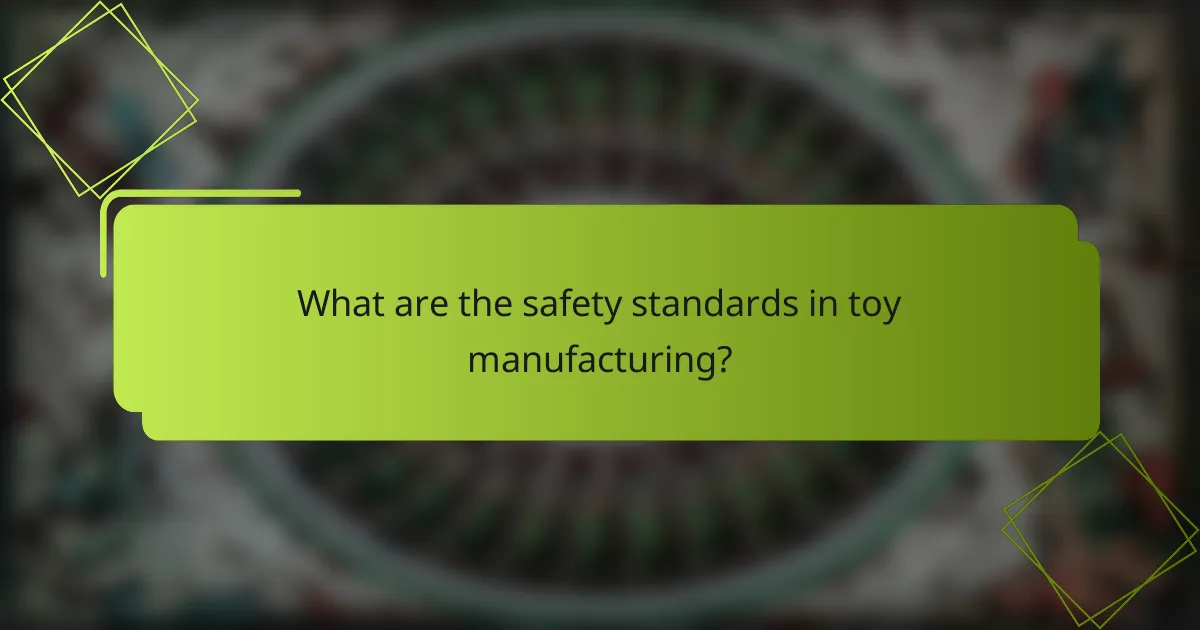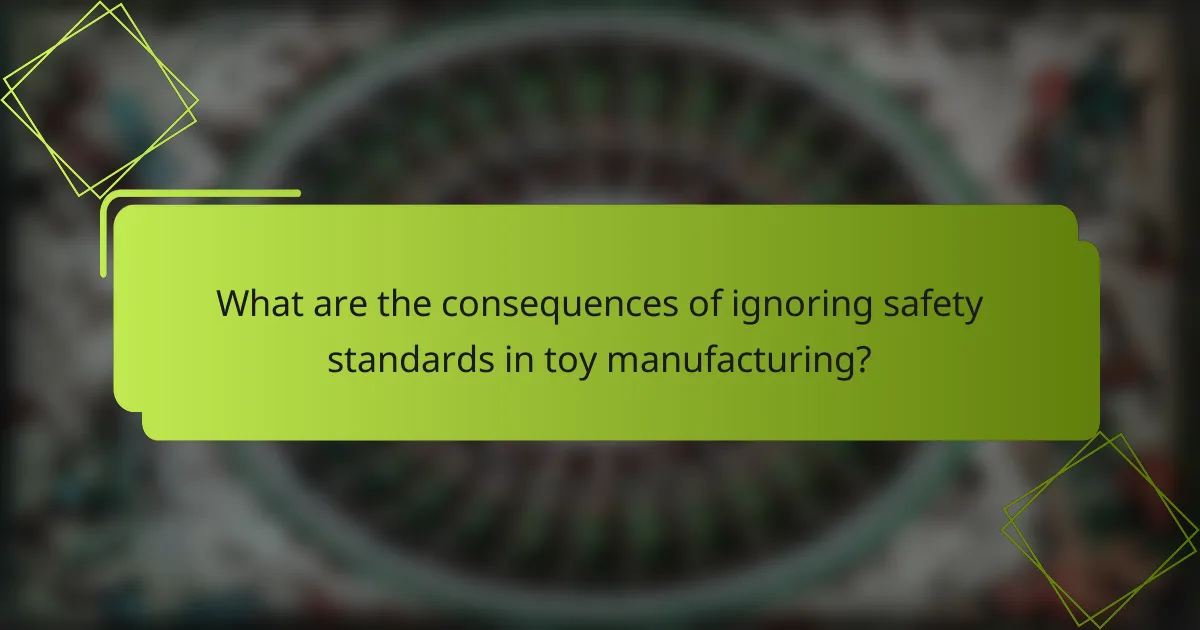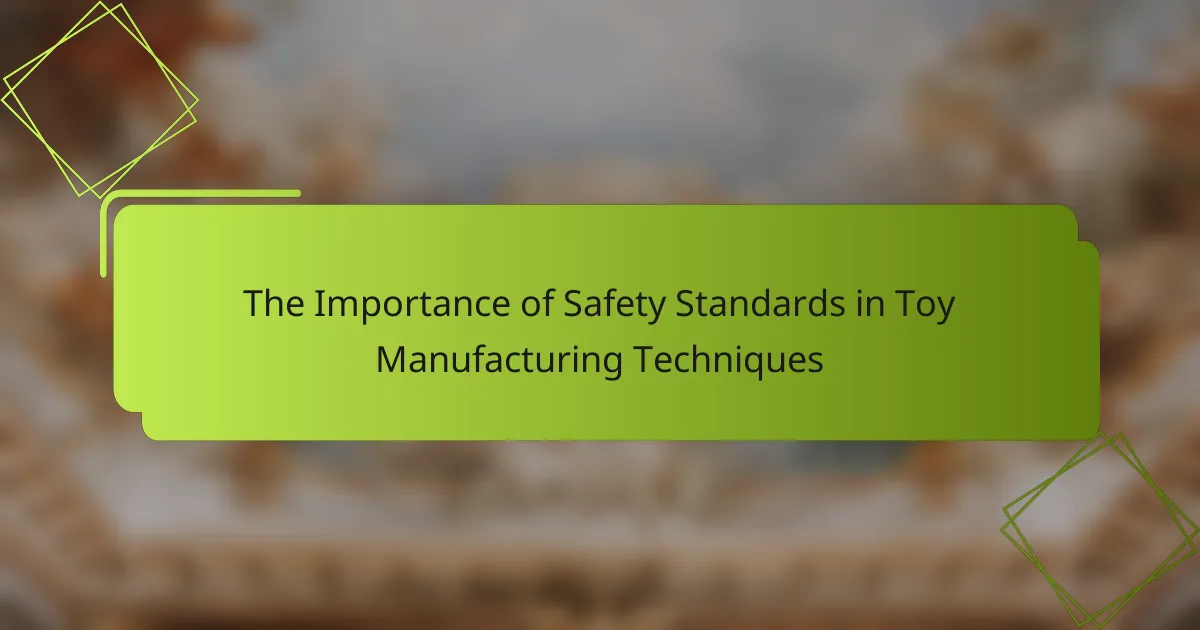
What are the safety standards in toy manufacturing?
Safety standards in toy manufacturing ensure that toys are safe for children. These standards include regulations on materials, design, and testing. For example, toys must be free from toxic substances like lead and phthalates. The Consumer Product Safety Commission (CPSC) in the United States sets these regulations. They require toys to undergo rigorous safety testing before reaching the market. Additionally, toys must have appropriate age labeling and warning labels for small parts. Compliance with these standards helps prevent injuries and promotes child safety. International standards, such as EN71 in Europe, also govern toy safety. These comprehensive regulations protect children from potential hazards associated with toys.
Why are safety standards crucial in the toy industry?
Safety standards are crucial in the toy industry to protect children’s health and safety. These standards ensure that toys are free from harmful materials and designed to prevent choking hazards. In 2020, the U.S. Consumer Product Safety Commission reported over 200,000 toy-related injuries annually. Adhering to safety standards reduces these risks significantly. Compliance with regulations helps manufacturers avoid legal liabilities and recalls. Additionally, safety standards build consumer trust in brands. Ultimately, they foster a safer play environment for children.
What risks are associated with non-compliance to safety standards?
Non-compliance to safety standards in toy manufacturing poses significant risks. These risks include potential harm to children, as unsafe toys can lead to injuries or fatalities. Inadequate safety measures may result in toys containing hazardous materials, such as lead or small choking hazards. Additionally, manufacturers face legal repercussions, including lawsuits and fines, which can severely impact their financial stability. Non-compliance can damage a brand’s reputation, leading to loss of consumer trust. According to the Consumer Product Safety Commission, over 200,000 toy-related injuries are reported annually in the U.S., highlighting the critical need for adherence to safety standards.
How do safety standards protect children and consumers?
Safety standards protect children and consumers by ensuring that products meet specific safety criteria. These standards minimize risks associated with hazardous materials and unsafe designs. For example, toys must be free from toxic substances like lead and phthalates. Compliance with safety standards reduces the likelihood of injuries from choking hazards or sharp edges. Regulatory bodies, such as the Consumer Product Safety Commission (CPSC), enforce these standards. Regular testing and certification processes help verify product safety before they reach the market. This proactive approach builds consumer trust and promotes safer environments for children.
What are the key safety standards governing toy manufacturing?
The key safety standards governing toy manufacturing include ASTM F963, EN71, and ISO 8124. ASTM F963 is a standard developed by the American Society for Testing and Materials. It outlines safety requirements for toys sold in the United States. EN71 is the European standard for toy safety, ensuring products meet health and safety requirements within the EU. ISO 8124 is an international standard that provides guidelines for the safety of toys globally. These standards address various aspects, including mechanical hazards, flammability, and chemical composition. Compliance with these standards is crucial for ensuring children’s safety during play.
Which organizations set these safety standards?
The organizations that set safety standards in toy manufacturing include the American Society for Testing and Materials (ASTM), the International Organization for Standardization (ISO), and the Consumer Product Safety Commission (CPSC). ASTM develops voluntary consensus standards that ensure product safety and quality. ISO provides international standards for various industries, including toys. The CPSC enforces federal regulations to protect consumers from hazardous products. These organizations play a crucial role in establishing guidelines that manufacturers must follow to ensure toy safety.
What specific regulations should manufacturers follow?
Manufacturers should follow specific regulations such as the Consumer Product Safety Improvement Act (CPSIA). This act mandates safety testing and certification for toys. It limits the amount of lead and phthalates in children’s products. Manufacturers must also comply with ASTM F963, the standard for toy safety. This standard includes requirements for mechanical and physical properties. Additionally, manufacturers should adhere to labeling requirements outlined by the Federal Trade Commission (FTC). Compliance with these regulations ensures the safety of toys for children. These regulations are enforced by the Consumer Product Safety Commission (CPSC). Non-compliance can lead to recalls and legal penalties.

How do safety standards impact toy design and production?
Safety standards significantly influence toy design and production. They ensure that toys are safe for children to use. Compliance with safety standards requires manufacturers to assess potential hazards. This includes evaluating sharp edges, small parts, and toxic materials. Safety testing is often mandated before a toy can be marketed. For example, the ASTM F963 standard outlines safety requirements for toys sold in the U.S. Manufacturers must perform rigorous testing to meet these standards. Failure to comply can result in recalls and legal consequences. Thus, safety standards shape the entire process of toy creation, from concept to market.
What role do safety standards play in the design phase of toys?
Safety standards are critical in the design phase of toys to ensure child safety. They guide manufacturers in selecting materials, shapes, and sizes that minimize risks. Compliance with these standards helps prevent hazards such as choking, sharp edges, and toxic substances. For instance, the ASTM F963 standard outlines specific safety requirements for toys sold in the U.S. These guidelines are based on extensive research and testing. Adhering to safety standards not only protects children but also builds consumer trust in toy brands. Moreover, failure to comply can result in recalls and legal consequences, emphasizing their importance in the design process.
How can manufacturers incorporate safety features in toy design?
Manufacturers can incorporate safety features in toy design by following established safety standards. This includes using non-toxic materials to prevent harmful exposure. They can also design toys with rounded edges to reduce injury risks. Additionally, implementing small part regulations prevents choking hazards for young children. Regular testing for durability ensures toys withstand typical play without breaking. Manufacturers should also include clear age recommendations to guide appropriate usage. Compliance with safety certifications like ASTM and EN71 helps validate their safety measures. These practices collectively enhance the safety of toys for consumers.
What materials are recommended to meet safety standards?
Materials recommended to meet safety standards in toy manufacturing include non-toxic plastics, natural wood, and organic fabrics. Non-toxic plastics such as polyethylene and polypropylene are safe for children. Natural wood should be sourced from sustainable forests and treated with child-safe finishes. Organic fabrics must be free from harmful chemicals and dyes. These materials minimize risks of choking hazards and toxic exposure. Compliance with ASTM F963 and EN71 standards ensures products are safe for children. Regular testing confirms that these materials meet safety regulations effectively.
How do safety standards affect manufacturing processes?
Safety standards significantly influence manufacturing processes by establishing guidelines that ensure product safety and quality. These standards dictate the materials used, machinery employed, and safety protocols followed during production. Compliance with safety standards minimizes the risk of accidents and injuries in the workplace. It also ensures that the final products meet consumer safety expectations. For example, in toy manufacturing, adherence to ASTM F963 ensures toys are free from hazardous materials. This compliance not only protects children but also enhances brand reputation. Manufacturers that follow safety standards often experience fewer recalls and legal issues. Consequently, safety standards lead to more efficient and responsible manufacturing practices.
What quality control measures are necessary for compliance?
Quality control measures necessary for compliance in toy manufacturing include regular inspections and testing of materials. These inspections ensure that all components meet safety standards. Testing must be conducted for mechanical and physical properties, including sharp edges and small parts. Compliance with regulatory requirements, such as ASTM F963 in the United States, is essential. Documentation of all quality control processes is required for accountability. Training staff on safety standards is also critical. Implementing corrective actions for any identified non-conformities ensures ongoing compliance. Regular audits by external parties can provide additional verification of adherence to safety standards.
How can manufacturers ensure ongoing compliance throughout production?
Manufacturers can ensure ongoing compliance throughout production by implementing rigorous quality control systems. These systems include regular inspections and testing of materials and finished products. Establishing clear protocols for compliance with safety standards is essential. Training employees on these protocols enhances adherence to regulations. Documentation of compliance activities provides a reliable audit trail. Utilizing third-party audits can identify areas for improvement. Continuous monitoring of production processes helps maintain compliance over time. Adapting to changes in regulations ensures that manufacturers stay up-to-date with safety standards.

What are the consequences of ignoring safety standards in toy manufacturing?
Ignoring safety standards in toy manufacturing can lead to severe consequences. These consequences include increased risk of injuries to children. Non-compliant toys may contain hazardous materials, posing health risks. Injuries from choking, sharp edges, or toxic substances are common. Legal actions can arise from lawsuits filed by affected families. Recalling unsafe toys can lead to significant financial losses for manufacturers. Damage to a brand’s reputation can result from public outcry over safety violations. Regulatory fines may be imposed for non-compliance with safety standards. Overall, neglecting safety standards jeopardizes child safety and business integrity.
What legal implications can arise from non-compliance?
Legal implications of non-compliance with safety standards in toy manufacturing can include significant penalties. Companies may face fines imposed by regulatory agencies, which can reach millions of dollars. Non-compliance can also lead to product recalls, resulting in financial losses and damage to brand reputation. Legal actions from consumers injured by unsafe toys may result in lawsuits and liability claims. In some jurisdictions, non-compliance can result in criminal charges against company executives. Regulatory bodies like the Consumer Product Safety Commission enforce strict compliance to protect consumers. Historical cases demonstrate that companies failing to adhere to safety standards often face severe repercussions, including bankruptcy. Compliance with safety standards is essential to mitigate these legal risks.
How can recalls impact a brand’s reputation?
Recalls can severely damage a brand’s reputation. When a product is recalled, it signals potential safety issues. Consumers often associate recalls with negligence or poor quality control. This can lead to a loss of trust among customers. In fact, a study by the Harvard Business Review found that brands experience a 20% decline in customer loyalty following a recall. Additionally, negative media coverage amplifies the impact, reaching a wider audience. Brands may also face legal repercussions, further tarnishing their image. Ultimately, a recall can have long-lasting effects on a brand’s credibility and market position.
What are the financial consequences of failing to meet safety standards?
Failing to meet safety standards in toy manufacturing can lead to significant financial consequences. Companies may face hefty fines imposed by regulatory bodies. For instance, the Consumer Product Safety Commission can levy penalties up to $15 million for violations. Legal liabilities may arise from lawsuits filed by consumers injured by unsafe toys. Insurance premiums can increase as a result of safety violations. Additionally, companies may experience loss of revenue due to product recalls, which can cost millions. Brand reputation can suffer, leading to decreased sales and customer trust. Overall, non-compliance with safety standards can have a devastating financial impact on toy manufacturers.
What best practices should manufacturers adopt to ensure safety compliance?
Manufacturers should adopt rigorous testing and quality assurance procedures to ensure safety compliance. This includes conducting regular safety audits and assessments throughout the production process. Compliance with national and international safety standards, such as ASTM and ISO, is essential. Manufacturers must also provide clear labeling and instructions for use on toy products. Training employees on safety protocols and compliance standards is crucial. Implementing a robust incident reporting system helps identify potential safety issues. Regularly reviewing and updating safety practices based on new regulations and industry standards is necessary. These practices help mitigate risks and protect consumers, ensuring toys are safe for children.
How can manufacturers stay updated on changing regulations?
Manufacturers can stay updated on changing regulations by subscribing to industry newsletters and regulatory agency updates. These resources provide timely information on new laws and compliance requirements. Joining industry associations can also be beneficial. These organizations often offer insights and training on regulatory changes. Attending trade shows and conferences allows manufacturers to network and learn directly from experts. Engaging with legal counsel specializing in regulatory affairs ensures compliance with the latest standards. Regularly reviewing government websites keeps manufacturers informed about new regulations. Utilizing compliance management software can streamline the process of tracking regulatory changes.
What training should be provided to staff regarding safety standards?
Staff should receive training on safety standards relevant to toy manufacturing. This includes understanding material safety, hazard identification, and risk assessment. Employees must learn proper handling and storage of materials. Training should cover compliance with regulations such as ASTM and EN71. Staff should be educated on emergency procedures and reporting unsafe conditions. Regular refresher courses should be scheduled to keep knowledge current. Evidence shows that companies with comprehensive safety training reduce workplace incidents by up to 50%.
What resources are available for manufacturers to understand safety standards?
Manufacturers can access various resources to understand safety standards. Key resources include government agencies like the Consumer Product Safety Commission (CPSC) in the U.S. They provide guidelines and regulations specific to toy safety. Industry associations, such as the American Society for Testing and Materials (ASTM), offer standards for toy safety testing. Online databases like ANSI and ISO provide access to international safety standards. Additionally, workshops and training programs are available through organizations like the Toy Industry Association. These resources help manufacturers stay compliant with safety regulations and ensure product safety.
Where can manufacturers find comprehensive guidelines on toy safety?
Manufacturers can find comprehensive guidelines on toy safety from organizations like the American Society for Testing and Materials (ASTM) and the Consumer Product Safety Commission (CPSC). ASTM provides standards such as F963, which outlines safety requirements for toys. The CPSC offers regulations that ensure toys are safe for children. These resources are crucial for compliance and best practices in toy manufacturing. Accessing these guidelines helps manufacturers create safe products.
What industry associations offer support and information on compliance?
The American Society for Testing and Materials (ASTM) offers support and information on compliance in toy safety standards. ASTM develops and publishes voluntary consensus standards for various products, including toys. The Toy Industry Association (TIA) also provides resources and guidance on compliance with safety regulations. TIA advocates for safe and responsible toy manufacturing practices. The International Organization for Standardization (ISO) establishes international standards for toy safety, aiding manufacturers in compliance. These associations are vital for staying updated on regulatory changes and best practices in the industry.
The main entity of the article is safety standards in toy manufacturing. The article provides a comprehensive overview of the critical role these standards play in ensuring the safety of toys for children, detailing regulations on materials, design, and testing. It discusses the importance of compliance with standards set by organizations such as the Consumer Product Safety Commission (CPSC) and the American Society for Testing and Materials (ASTM), highlighting the risks associated with non-compliance, including potential legal repercussions and harm to children. Additionally, the article outlines best practices for manufacturers to adhere to safety standards and the resources available for understanding and implementing these regulations.



